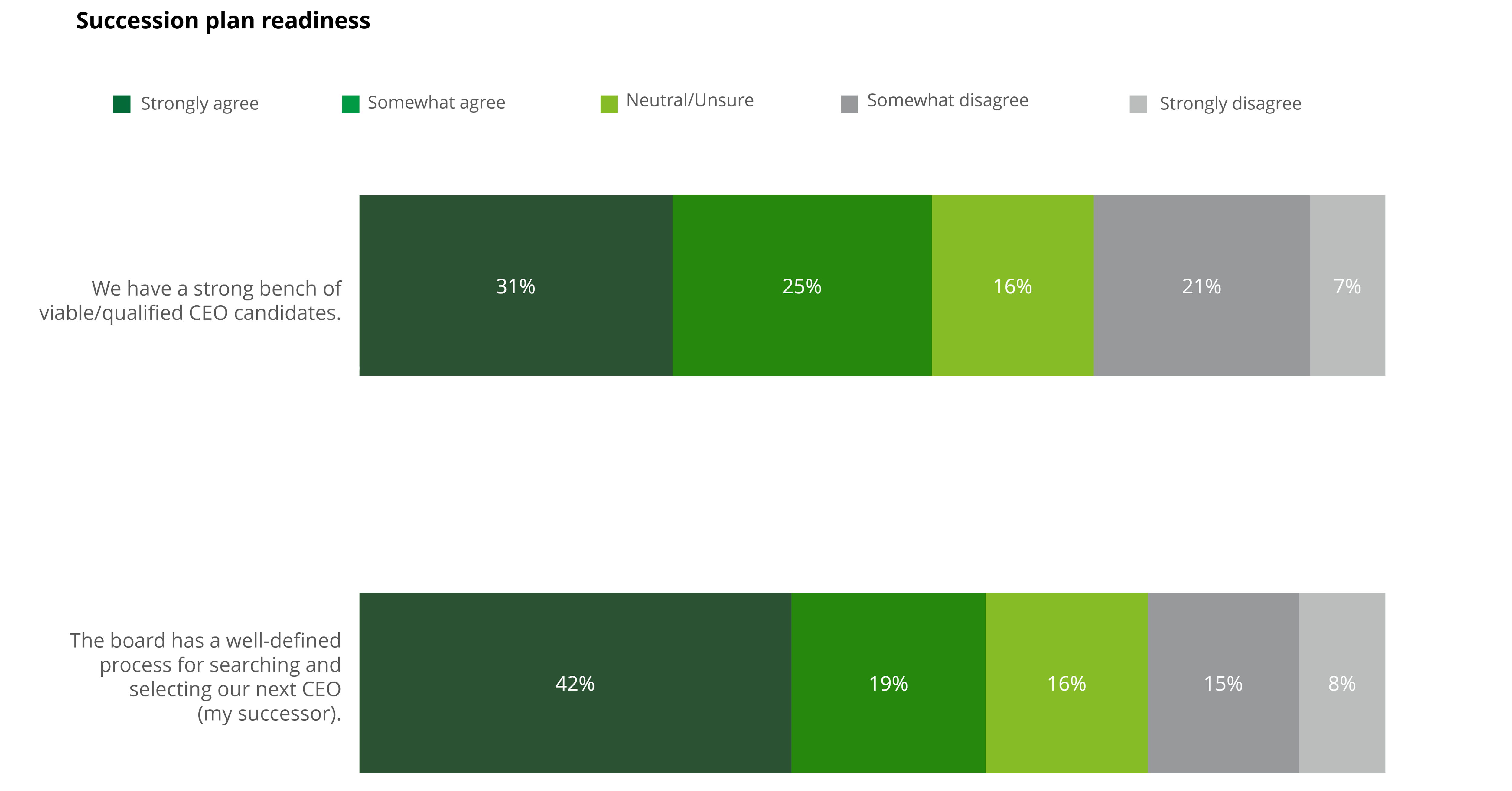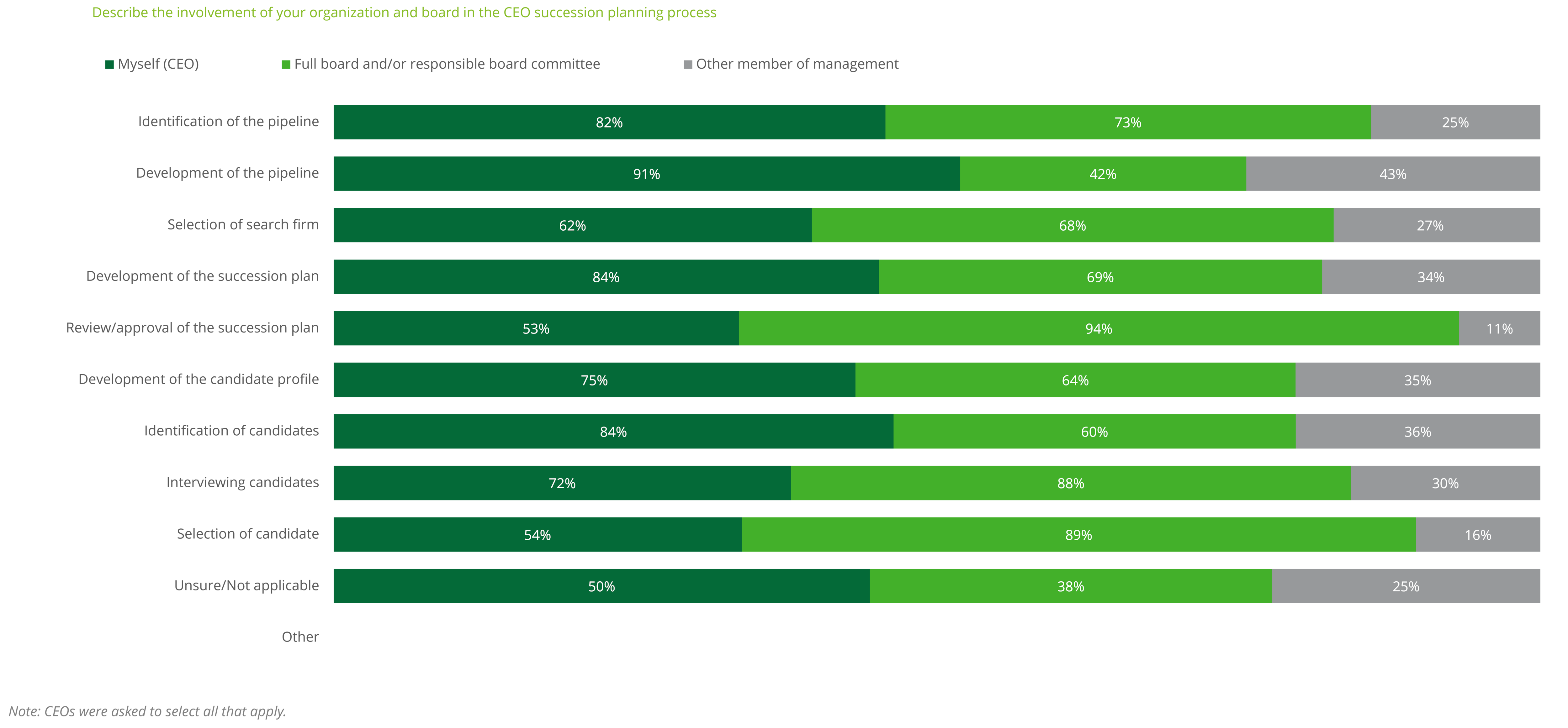The role of the CEO in succession planning has been saved

Perspectives
The role of the CEO in succession planning
CEO Spotlight Series
CEOs share perspectives on their role in the succession process from the recent Fortune/Deloitte survey.
CEO succession is becoming a larger part of the business dialogue with a number of recent high-profile transitions. This demonstrates that CEOs should be thinking about succession planning almost from the very moment they assume their new role. But what exactly is the CEO’s role in planning for their successor? While the succession process—including the CEO’s role in it—varies from company to company, there are some commonalities across organizations. This edition of our CEO Spotlight Series explores data from the Winter 2024 Fortune/Deloitte CEO survey to better understand the perceived role of incumbent CEOs in succession planning at their organizations, and what this could mean as CEOs think about preparing their organizations.
CEO succession planning can be a challenge for businesses today, especially with the increasing turnover and decreasing tenure of CEOs. A Harvard Law School study found that the median CEO tenure among the S&P 500 companies has decreased 20% in less than a decade, from six years in 2013 to 4.8 years in 2022. In 2023 alone, over 1,400 U.S. CEOs resigned, the highest number reported since the mid-2010s. While some of those cases may be the result of a higher exodus following a number of postponed departures during the COVID-19 pandemic, succession planning remains a perennial issue. “CEO succession” was cited as a top challenge by CEOs, and these trends indicate that CEOs and their boards may need to be even more proactive and strategic in preparing for an effective CEO transition.
A plan in place, but uncertain pipeline
As part of the Winter 2024 Fortune/Deloitte CEO Survey, we asked leaders about the process at their organization for selecting the next CEO (their successor). More than half (61%) of respondents agreed or strongly agreed that their respective boards have a well-defined process in place for searching and selecting the next CEO. Similarly, a recent survey of corporate secretaries indicated that the majority of organizations have a plan in place for CEO departures—whether planned (67%) or unplanned (80%) and in most cases that plan is documented.
While CEOs report confidence in their organization’s succession plan itself, they are less sure about the candidate pipeline. Only about a third (31%) of CEO respondents strongly agreed that their company has a strong slate of viable, future CEO candidates, with almost half unsure or disagreeing to some degree. In other words, this data suggests that perhaps the current challenge is not creating a plan for the CEO succession process, but rather proactively preparing for the process, including actively developing the pipeline to be ready when the time comes.

Figure 1. CEOs report their boards have a strong process in place (Source: Fortune/Deloitte CEO Survey Winter 2024)
Where does the CEO fit in?
CEO selection is undisputedly the responsibility of the executive board, yet the incumbent CEO still plays a significant role. According to the Winter 2024 Survey, CEO respondents perceive themselves as involved throughout all stages of the succession planning process, while they consider the board more involved in later phases of the process, such as interviewing and selecting candidates.
One area where CEOs and boards do agree is that CEOs may play a more significant role in earlier phases of the process, particularly identifying and developing potential successors. A remarkable 82% of CEO respondents (Figure 2) and 67% of board responses indicated that CEOs are involved in identification of the candidate pipeline. At the same time, 91% of CEO respondents reported involvement with development of this pipeline, which suggests that the sitting CEO can have a direct, and significant, impact on building the pool of viable candidates.
Being involved in the pipeline identification and development can take many forms, but there are some aspects that may be worth prioritizing. For example, according to one CEO we heard from, “I don’t think we do enough formal leadership development planning for executive roles in the United States. I see my role in the process as giving the candidates the opportunities they need to become the best possible contenders for the role. Then it is up to the board.”
From a CEO's perspective, it is important to understand the board's expectations and criteria, and to provide honest, constructive feedback and guidance to the potential internal candidates throughout their development process. This can begin long before the actual succession process in the form of leadership development plans and growth opportunities for internal candidates, and may in fact be an area for incumbent CEOs to further lean in.

Figure 2. CEOs report involvement throughout the succession process (Source: Fortune/Deloitte CEO Survey Winter 2024)
Conclusions: Aligning all parties
The survey findings suggest varying levels of alignment between CEOs and boards across the succession process. CEOs and their boards should consider working together to improve their succession planning practices. This includes better alignment and communication between the two parties, addressing the disconnect between the CEO successor development process and the pool of qualified CEO candidates, and ensuring a smooth and effective transition. By taking these proactive and strategic actions, CEOs and their boards can improve their chances of finding and developing the right leaders for the future.
Contributions: Andrew Heyward, Specialist Senior, Deloitte Consulting LLP and Jamie McCall, Manager, Center for Board Effectiveness, Deloitte LLP.


